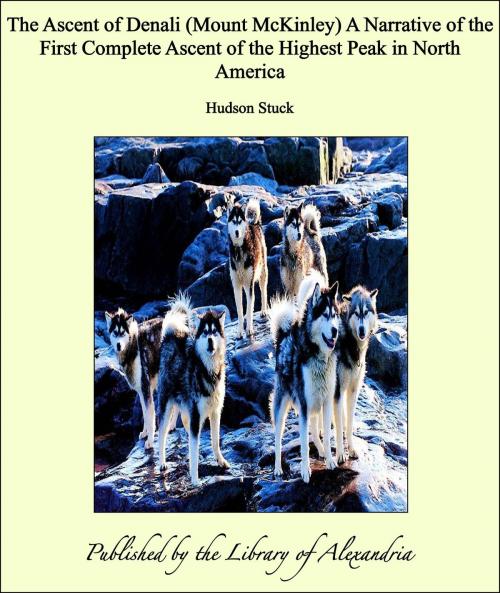The Ascent of Denali (Mount McKinley) A Narrative of the First Complete Ascent of the Highest Peak in North America
Nonfiction, Religion & Spirituality, New Age, History, Fiction & Literature| Author: | Hudson Stuck | ISBN: | 9781465555502 |
| Publisher: | Library of Alexandria | Publication: | March 8, 2015 |
| Imprint: | Language: | English |
| Author: | Hudson Stuck |
| ISBN: | 9781465555502 |
| Publisher: | Library of Alexandria |
| Publication: | March 8, 2015 |
| Imprint: | |
| Language: | English |
Forefront in this book, because forefront in the author’s heart and desire, must stand a plea for the restoration to the greatest mountain in North America of its immemorial native name. If there be any prestige or authority in such matter from the accomplishment of a first complete ascent, “if there be any virtue, if there be any praise,” the author values it chiefly as it may give weight to this plea. It is now little more than seventeen years ago that a prospector penetrated from the south into the neighborhood of this mountain, guessed its height with remarkable accuracy at twenty thousand feet, and, ignorant of any name that it already bore, placed upon it the name of the Republican candidate for President of the United States at the approaching election—William McKinley. No voice was raised in protest, for the Alaskan Indian is inarticulate and such white men as knew the old name were absorbed in the search for gold. Some years later an officer of the United States army, upon a reconnoissance survey into the land, passed around the companion peak, and, alike ignorant or careless of any native name, put upon it the name of an Ohio politician, at that time prominent in the councils of the nation, Joseph Foraker. So there they stand upon the maps, side by side, the two greatest peaks of the Alaskan range, “Mount McKinley” and “Mount Foraker.” And there they should stand no longer, since, if there be right and reason in these matters, they should not have been placed there at all. To the relatively large Indian population of those wide regions of the interior of Alaska from which the mountains are visible they have always borne Indian names. The natives of the middle Yukon, of the lower three hundred miles of the Tanana and its tributaries, of the upper Kuskokwim have always called these mountains “Denali” (Den-ah′li) and “Denali’s Wife”—either precisely as here written, or with a dialectical difference in pronunciation so slight as to be negligible. It is true that the little handful of natives on the Sushitna River, who never approach nearer than a hundred miles to the mountain, have another name for it. They call it Traléika, which, in their wholly different language, has the same signification. It is probably true of every great mountain that it bears diverse native names as one tribe or another, on this side or on that of its mighty bulk, speaks of it. But the area in which, and the people by whom, this mountain is known as Denali, preponderate so greatly as to leave no question which native name it should bear. The bold front of the mountain is so placed on the returning curve of the Alaskan range that from the interior its snows are visible far and wide, over many thousands of square miles; and the Indians of the Tanana and of the Yukon, as well as of the Kuskokwim, hunt the caribou well up on its foot-hills. Its southern slopes are stern and forbidding through depth of snow and violence of glacial stream, and are devoid of game; its slopes toward the interior of the country are mild and amene, with light snowfall and game in abundance
Forefront in this book, because forefront in the author’s heart and desire, must stand a plea for the restoration to the greatest mountain in North America of its immemorial native name. If there be any prestige or authority in such matter from the accomplishment of a first complete ascent, “if there be any virtue, if there be any praise,” the author values it chiefly as it may give weight to this plea. It is now little more than seventeen years ago that a prospector penetrated from the south into the neighborhood of this mountain, guessed its height with remarkable accuracy at twenty thousand feet, and, ignorant of any name that it already bore, placed upon it the name of the Republican candidate for President of the United States at the approaching election—William McKinley. No voice was raised in protest, for the Alaskan Indian is inarticulate and such white men as knew the old name were absorbed in the search for gold. Some years later an officer of the United States army, upon a reconnoissance survey into the land, passed around the companion peak, and, alike ignorant or careless of any native name, put upon it the name of an Ohio politician, at that time prominent in the councils of the nation, Joseph Foraker. So there they stand upon the maps, side by side, the two greatest peaks of the Alaskan range, “Mount McKinley” and “Mount Foraker.” And there they should stand no longer, since, if there be right and reason in these matters, they should not have been placed there at all. To the relatively large Indian population of those wide regions of the interior of Alaska from which the mountains are visible they have always borne Indian names. The natives of the middle Yukon, of the lower three hundred miles of the Tanana and its tributaries, of the upper Kuskokwim have always called these mountains “Denali” (Den-ah′li) and “Denali’s Wife”—either precisely as here written, or with a dialectical difference in pronunciation so slight as to be negligible. It is true that the little handful of natives on the Sushitna River, who never approach nearer than a hundred miles to the mountain, have another name for it. They call it Traléika, which, in their wholly different language, has the same signification. It is probably true of every great mountain that it bears diverse native names as one tribe or another, on this side or on that of its mighty bulk, speaks of it. But the area in which, and the people by whom, this mountain is known as Denali, preponderate so greatly as to leave no question which native name it should bear. The bold front of the mountain is so placed on the returning curve of the Alaskan range that from the interior its snows are visible far and wide, over many thousands of square miles; and the Indians of the Tanana and of the Yukon, as well as of the Kuskokwim, hunt the caribou well up on its foot-hills. Its southern slopes are stern and forbidding through depth of snow and violence of glacial stream, and are devoid of game; its slopes toward the interior of the country are mild and amene, with light snowfall and game in abundance















